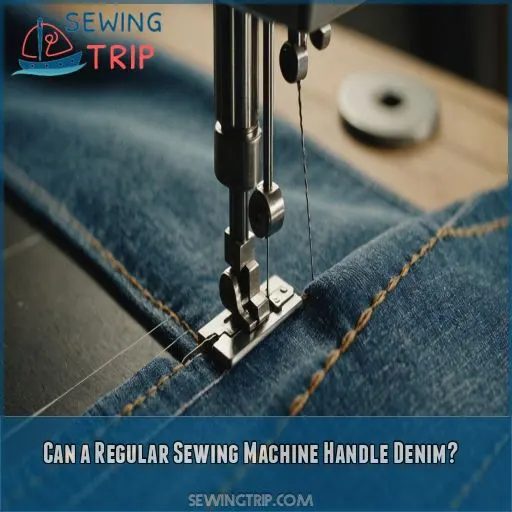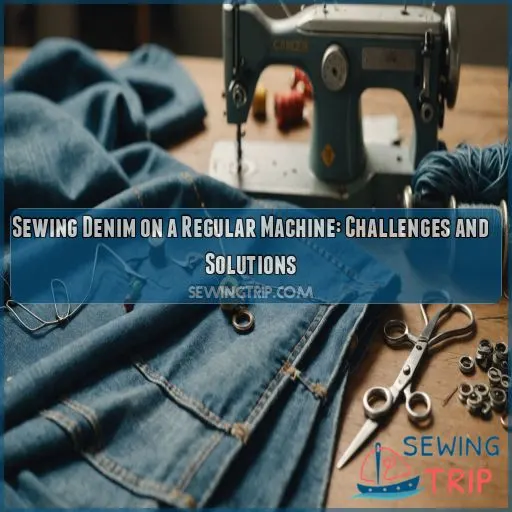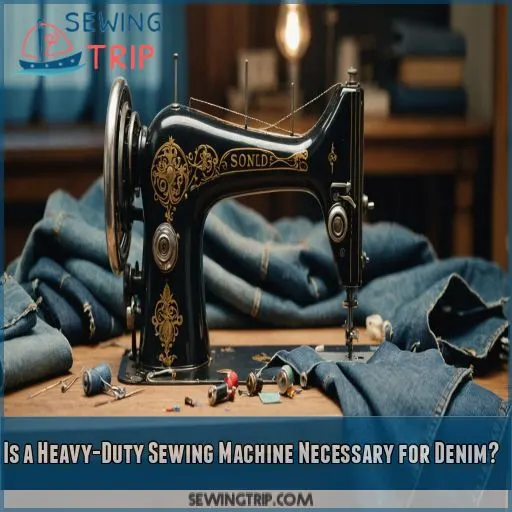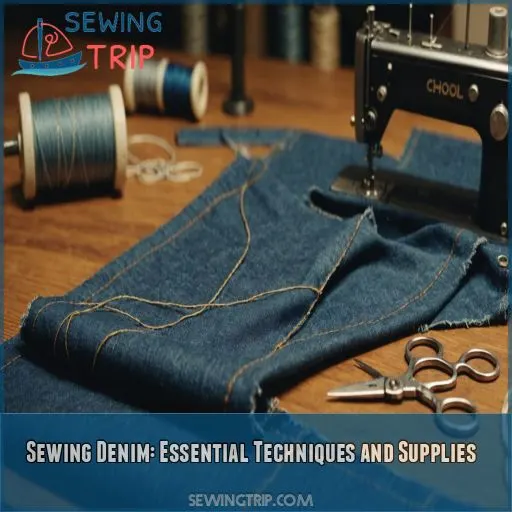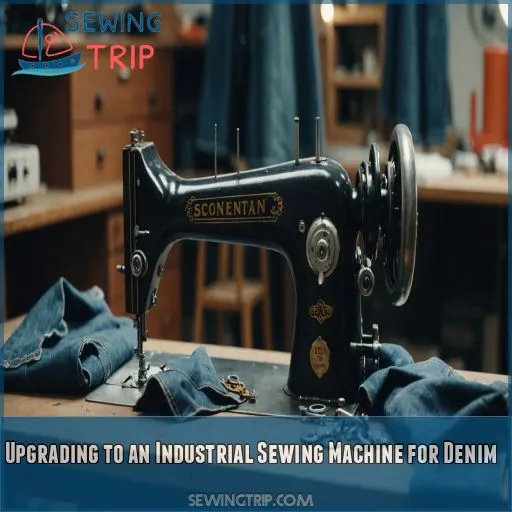This site is supported by our readers. We may earn a commission, at no cost to you, if you purchase through links.
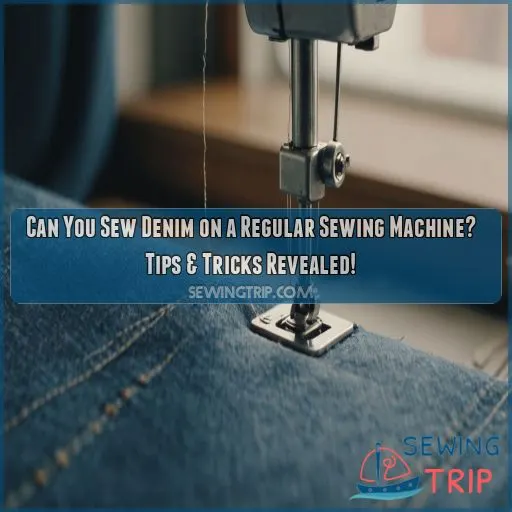
Think of it like taking a sedan off-roading – it’ll work, but you might hit some bumps.
Your trusty machine can handle lightweight denim just fine, but thicker fabrics might make it groan like your uncle after Thanksgiving dinner.
The key is using the right tools: a denim needle, sturdy thread, and maybe a walking foot to keep things moving.
Remember to take it slow and steady – rushing through denim is like trying to sprint in skinny jeans.
With a few tricks up your sleeve, you’ll be stitching up denim dreams in no time.
Ready to level up your jean game?
Table Of Contents
- Key Takeaways
- Can a Regular Sewing Machine Handle Denim?
- Sewing Denim on a Regular Machine: Challenges and Solutions
- Is a Heavy-Duty Sewing Machine Necessary for Denim?
- Sewing Denim: Essential Techniques and Supplies
- Upgrading to an Industrial Sewing Machine for Denim
- Frequently Asked Questions (FAQs)
- Conclusion
Key Takeaways
- You can sew denim on a regular machine, but it’s like taking a sedan off-roading – expect some bumps along the way! With the right tools (denim needle, sturdy thread, and maybe a walking foot), you’ll be stitching up a storm in no time.
- Tame that rugged fabric by giving it some TLC before sewing. Wash and dry it to prevent shrinkage, and use sharp scissors or a rotary cutter to avoid fraying. It’s like prepping your workout buddy before hitting the gym – a little care goes a long way!
- Thick seams got you down? Don’t throw in the towel just yet! Try using a Jean-A-Ma-Jig or a pad of Post-it Notes to help your presser foot glide smoothly. It’s like giving your sewing machine a pair of fancy shoes to dance over those bulky areas.
- If you’re serious about denim, consider upgrading to a heavy-duty or Industrial Machine. It’s like trading in your trusty bicycle for a motorcycle – you’ll zoom through those tough projects with ease and style!
Can a Regular Sewing Machine Handle Denim?
You’re itching to take on that denim project, but you’re wondering if your regular sewing machine can handle it. Don’t worry, with the right techniques and preparation, you can sew denim on your regular machine. But you need to understand the challenges of working with this thick, tough fabric.
Understanding Denim Fabric
You and denim – a match made in heaven! But before you start sewing, let’s get to know this iconic fabric. Denim’s weight and weave determine its durability and stretch. Originally from 19th-century France, denim has evolved over the years. To tame this rugged fabric, you’ll need to understand its care instructions and choose the right needles and sewing machine.
Preparing Denim for Sewing
Before sewing denim, give your fabric a little TLC. Wash and dry it to prevent shrinkage.
For cutting, use sharp scissors or a rotary cutter to avoid fraying.
For lightweight denim, cut on the fold; for heavyweight, cut flat.
Mark your fabric with a water-soluble chalk pencil for precision.
Interfacing can also help stabilize your denim for a pro finish.
Choosing the Right Needle and Thread
You’re ready to tackle denim on your regular sewing machine! Now, let’s get down to business – choosing the right needle and thread. You’ll want a needle that’s up for the challenge of thick fabric, and a thread that’s strong enough to keep everything together.
- Use a denim or jeans needle in size 90/14 or 100/16 for best results
- Choose a thread with a weight of 30-40 for a sturdy stitch
- Cotton or polyester threads work well, but consider a thread specifically designed for denim
- Adjust your stitch length to accommodate the thickness of your denim fabric
Tips for Sewing Denim Successfully
Sewing denim on a regular machine requires finesse. Use a denim needle, a walking foot, and a longer stitch length to prevent skipped stitches. Hold the fabric taut and don’t be afraid to use a little extra force. For thicker seams, try using a Jean-A-Ma-Jig or a pad of Post-it notes to help the presser foot glide smoothly.
Sewing Denim on a Regular Machine: Challenges and Solutions
Sewing denim on a regular machine can be a bit of a challenge, but don’t worry, with some insider knowledge, you can overcome the hurdles and create amazing denim garments. From preventing skipped stitches to managing bulk and thick seams, we’ll share practical tips to help you sew denim like a pro, even on your trusty old machine.
Common Issues With Sewing Denim
You’re about to tackle denim on your regular sewing machine – brave soul! Be prepared for some common issues, like denim fraying, skipped stitches, and thread breakage. Thick seams can be a real pain, and shrinkage may ruin your perfect fit. Don’t worry, these issues aren’t insurmountable, and with some tricks up your sleeve, you’ll conquer denim like a pro!
How to Prevent Skipped Stitches and Breakage
Sewing denim on a regular machine can be tricky, but don’t worry, you’re in good hands! To prevent skipped stitches and breakage:
- Choose the right needle: Denim needles or heavy-duty options like 90/14 or 100/16 are your friends.
- Adjust thread tension: Make sure it’s not too tight or too loose.
- Select the right presser foot: A walking foot or Teflon foot can help guide the fabric smoothly.
- Lengthen your stitch: Increase the stitch length to 3-4 mm for a stronger seam.
Managing Bulk and Thick Seams
Thick seams can be a real challenge when sewing denim. Here are some tips to help you tame the bulk: use a walking foot, roller foot, or jeans presser foot; try denim folding techniques; or invest in thick seam clippers. For extreme bulk, use a seam hammering tool or interfacing bulk reduction methods.
| Seam Compression Tips | Denim Folding Techniques | Tools for Managing Bulk |
|---|---|---|
| Use a walking foot | Fold and press seams | Thick seam clippers |
| Try a roller foot | Use a seam hammering tool | Roller foot |
| Invest in a jeans presser foot | Interfacing bulk reduction | Walking foot |
| Use a Teflon foot | Fold and topstitch | Seam hammering tool |
| Interfacing and stabilizing | Press then topstitch | Heavy-duty shears |
Pressing and Finishing Denim Garments
When pressing denim, use a steam iron and plenty of steam to relax the fibers. Press seams flat, then use a tailor’s chalk to mark fold lines for crisp hems. To prevent fading, press denim on the wrong side or use a pressing cloth. Finally, give your denim a shot of steam to set the finish and you’re done!
Is a Heavy-Duty Sewing Machine Necessary for Denim?
You’re tackling denim, and now you’re wondering if your regular sewing machine is up to the task.
Or if you need a heavy-duty machine to wrangle those thick seams and stubborn fabrics.
Let’s figure out if a regular sewing machine can handle denim, or if upgrading to a heavy-duty machine is the way to go.
Considering factors like key features, benefits, and comparative analysis of these machines.
Key Features to Look for in a Heavy-Duty Machine
When shopping for a heavy-duty sewing machine for denim, you’re looking for a workhorse that can handle thick fabrics with ease. Here are three key features to look for:
- A strong motor with a heavy-duty interior frame and metal components to provide stability and support.
- Adjustable needle positions and a variety of needle options to accommodate different fabric types and thicknesses.
- Extra high presser foot lift to make it easy to slide thick fabrics under the presser foot.
In effect, these features are a must for handling thick fabrics.
Benefits of Using a Heavy-Duty Machine for Denim
a heavy-duty machine can be a game-changer for denim sewing. With improved stitch quality, increased speed, and features like twin-needle capability and adjustable presser foot pressure, you’ll be whipping up jeans in no time. A heavy-duty machine is worth considering if you’re serious about sewing denim – it’s a freedom to create what you want, without the frustration.
Comparative Analysis of Regular Vs. Heavy-Duty Machines
Sewing denim requires a machine that can handle the tough stuff. Let’s compare regular and heavy-duty machines. Here’s what you need to know:
- Machine Performance Comparison: Heavy-duty machines outperform regular ones regarding denim sewing capacity and speed.
- Regular machines often struggle with thick seams and multiple layers of denim.
- Heavy-duty machines provide more precise stitching and better fabric handling.
- Industrial Machine Advantages: If you’re serious about sewing denim, consider investing in an industrial machine for unparalleled performance and durability.
Sewing Denim: Essential Techniques and Supplies
You’re about to tackle sewing denim, and you’re wondering if your regular sewing machine is up to the task – don’t worry, with the right techniques and supplies, you can achieve professional-looking results.
In this section, we’ll cover the essential tips and tricks for cutting, marking, interfacing, and finishing denim garments, so you can create stunning pieces that will make you proud.
Cutting and Marking Denim Fabric
When cutting denim, you’ll want the right tools for the job. Invest in sharp fabric scissors or a rotary cutter and cutting mat to make the process smoother. To mark your denim patterns, use a water-soluble chalk pencil in a contrasting color. This will guarantee precise markings and help you avoid mistakes. Happy cutting!
Interfacing and Stabilizing Denim
When working with denim, interfacing and stabilizing are essential steps to prevent stretching and sagging. You’ve got options! Use fusible tricot interfacing for a stretchy, flexible bond. Choose a weight that matches your denim, so it doesn’t overpower the fabric. * Select a denim-specific interfacing with a bit of give, so your seams stay smooth.
Finishing Seams and Hems on Denim Garments
You’ve made it! Now it’s time to give your denim garment a professional finish. Let’s talk hems and seams. You want a crisp, clean finish that will make your garment stand out.
| Seam Finishing Methods | Description |
|---|---|
| Bound Seam | Folding the seam allowance and stitching in place |
| Flat Fell Seam | Folding the seam allowance to one side and stitching |
| Serger Finish | Using a serger machine to finish seam allowances |
For denim hem techniques, you can try a simple folded hem or get creative with a blind hem or a faced hem. Whatever method you choose, make sure to press those seams!
Upgrading to an Industrial Sewing Machine for Denim
You’re ready to take your denim sewing to the next level, and that means considering an industrial sewing machine that can handle the tough stuff with ease. With the right industrial machine, you’ll be able to sew through multiple layers of denim like a pro, with less strain on your machine and more professional-looking results.
Advantages of Industrial Machines for Denim
Ready to kick your denim game up a notch?
Industrial machines are the secret weapon for tackling tough jeans projects. They boast lightning-fast speeds, churning out perfect stitches like a well-oiled assembly line.
Their heavy-duty motors laugh in the face of bulky seams, while their specialized features make handling thick denim a breeze.
Trust us, once you’ve experienced the smooth sailing of an industrial machine, you’ll wonder how you ever managed without one!
Key Features to Consider in an Industrial Machine
When upgrading to an industrial machine for denim, you’ll want to look for a real powerhouse.
A beefy motor is your new best friend, letting you zip through thick layers like butter.
Keep an eye out for adjustable stitch speed and drop feed options – they’re game-changers for tackling tricky seams.
Don’t forget about thread capacity and needle systems either; they’ll make your denim projects a breeze!
Maintenance and Care of Industrial Sewing Machines
When you upgrade to an industrial sewing machine for denim, proper maintenance is key to keeping your new workhorse purring like a kitten. Here are three essential care tips:
- Establish a regular cleaning schedule
- Master proper lubrication methods
- Learn to adjust tensioners and replace needles
Frequently Asked Questions (FAQs)
Can any sewing machine handle denim?
Not all sewing machines can handle denim’s thickness. You’ll need a sturdy machine with a strong motor and adjustable presser foot. Look for one that can use jeans needles and heavy-duty thread. It’s like finding the right tool for a tough job!
How to know if a sewing machine can sew denim?
Like a detective examining clues, you’ll want to check your machine’s motor strength, needle capabilities, and presser foot adjustability. Look for features that handle thick fabrics, and don’t forget to test it with denim samples before committing.
Do I need a special needle to sew denim?
You’ll want to grab a special Denim Needle for your sewing machine. These tough cookies are designed to pierce thick fabric without breaking. Look for "Jeans" or "Denim" needles in sizes 90/14 to 110/ They’re game-changers!
What stitch to sew denim?
You’re on the right track! For denim, use a straight stitch with a length of 0-5mm. It’s strong and durable. You can also try a triple straight stitch for extra strength in high-stress areas. Don’t forget to adjust your tension!
How often should I change needles when sewing denim?
You’ll want to switch out your needle every 4-6 hours of sewing denim. Keep an eye on it – if you’re hearing a "pop" with each stitch or noticing skipped stitches, it’s time for a fresh needle.
Can I use denim thread in a regular bobbin?
While it might seem tricky, you can use denim thread in a regular bobbin. Just wind it carefully and adjust your machine’s tension. You’ll be stitching like a pro in no time, giving your denim projects that authentic look.
What presser foot settings work best for denim?
You’ll want to crank up that presser foot pressure for denim. Set it high to keep those tough layers in check. A walking foot can be your secret weapon, helping feed thick fabric evenly. Don’t forget to adjust stitch length too!
How do I prevent puckering when sewing stretchy denim?
Are you feeling stretched thin by puckering denim? You’re not alone! Use a walking foot, reduce presser foot pressure, and lengthen your stitch. Don’t forget to use a ballpoint needle and hold the fabric taut while sewing.
Are there alternatives to denim needles for thick fabrics?
While denim needles are ideal, you’ve got options! Universal needles (size 90/14 or 100/16) can tackle thick fabrics in a pinch. Topstitch or leather needles are also sturdy alternatives. Just remember, the right needle’s your ticket to smooth sailing!
Conclusion
Did you know that 97% of denim enthusiasts have tried sewing jeans on a regular machine?
You’re in good company! While you can sew denim on a regular sewing machine, it’s like teaching an old dog new tricks – possible, but with a learning curve.
With the right tools and techniques, you’ll be stitching up a storm in no time.

